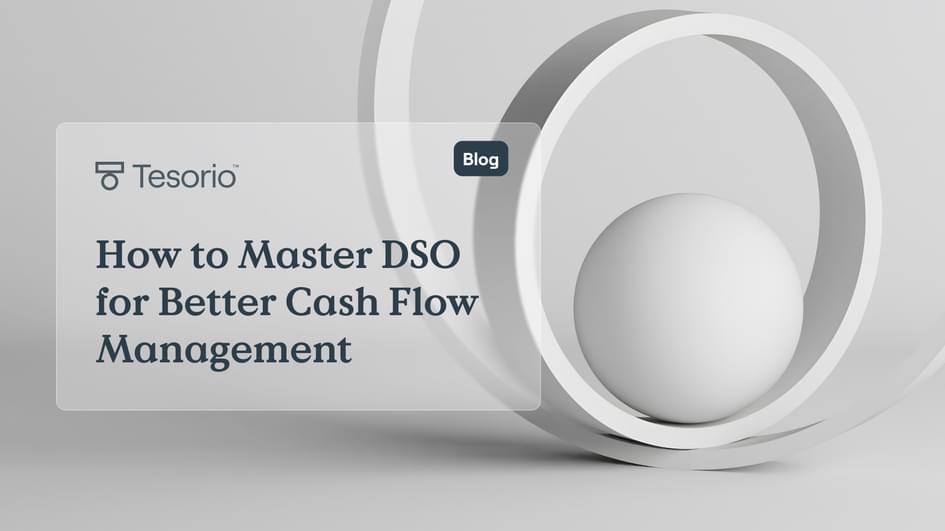How to Master DSO for Better Cash Flow Management

Cash flow isn't just about keeping operations running, it's a strategic imperative that determines your company's ability to invest, grow, and survive market fluctuations. Days Sales Outstanding (DSO) is one of the most powerful levers finance leaders can use to transform cash flow performance from a reactive concern into a proactive advantage.
Why DSO Matters: The Root Cause of Cash Flow Problems
Many finance teams find themselves stuck in a cycle of cash flow crises not merely because of late payments, but due to disconnected systems and reactive processes that obscure what's really happening with receivables. The common pattern is all too familiar: cash flow tightens, aging reports are reviewed, collections are expedited, cash inflow improves, and then the cycle repeats. Without embracing strategic DSO management, companies become overly reliant on external financing, limiting growth and increasing vulnerability during downturns.
Step 1: Understand What DSO Really Measures
DSO is more than just a number—it's an indicator of operational efficiency, customer relationships, and overall financial health. By measuring the average number of days it takes to convert credit sales into cash, DSO reveals how effective your collections are. The formula is simple:
DSO = (Accounts Receivable / Total Credit Sales) × Number of Days in Period
For instance, if your AR balance is $500,000 and total credit sales for the month are $1,000,000, then: DSO = ($500,000 / $1,000,000) × 30 = 15 days
Every day you reduce from your DSO means more free cash becomes available—cash that can be reinvested in growth initiatives without additional financing.
Step 2: Diagnose Your Current DSO Performance
Before improving your DSO, it’s crucial to understand current performance and pinpoint causes for delays. Benchmark your DSO against industry standards, analyze trends over time, and even break down the metric by customer segment to identify outliers.
Common causes for a high DSO include: • Inconsistent invoicing practices • Manual and fragmented collections workflows • Limited visibility into customer payment behaviors • Disconnected systems across AR, sales, and customer success • Ambiguous payment terms that create friction during the payment process
Step 3: Implement a Proactive DSO Strategy
To shift from reactive collections to proactive cash flow management, consider these steps:
• Automate the Collections Process:
Set up automated payment reminders before invoices become overdue.
Personalize communications based on each customer’s payment history.
Prioritize collections using AI-driven insights for maximum impact.
• Optimize Payment Terms and Methods:
Offer early-payment incentives for customers who consistently pay late.
Provide a variety of payment options to ease the payment process.
Consider auto-pay solutions for recurring customers to streamline collection.
• Connect Your Financial Systems:
Integrate your AR automation tools with ERP and CRM systems.
Ensure real-time data exchange to keep cash flow forecasts accurate.
Use dashboards to provide cross-functional visibility into DSO performance.
Step 4: Leverage Technology to Transform DSO Performance
Modern AR automation platforms, like Tesorio’s AI-driven Connected Financial Operations solution, are designed to elevate your DSO management:
• Real-Time Cash Flow Visibility:
Monitor DSO and related metrics on dynamic dashboards.
Track payment trends to flag potential issues before they escalate.
Share actionable cash flow insights across finance, sales, and customer success teams.
• AI-Powered Collections:
Use machine learning to predict customer payment behavior.
Automatically prioritize collections activities based on predicted impact.
Generate tailored outreach campaigns that both strengthen customer relations and accelerate payments.
• Automated Workflows:
Automate invoice delivery and follow-up processes.
Automatically reconcile payments to minimize manual intervention.
Develop custom workflows that adapt to different customer segments and their behaviors.
Step 5: Measure and Optimize Your DSO Strategy
Continuous improvement is key. Regularly review and refine your DSO strategy by tracking these metrics:
- Trends over time – aim for consistent reduction in DSO.
- DSO-to-DPO ratio – balance the speed of cash collection with payable management.
- Collections effectiveness index – measure the percentage of collectible AR that is successfully collected.
- Average days delinquent and AR aging buckets – identify where delays persist.
Companies that master DSO management gain a competitive edge by improving cash flow predictability, reducing financing costs, and enhancing overall operational agility.
Real-World Impact
The transformative potential of strategic DSO management is clear: • Tesorio clients typically see a 33-day reduction in DSO. • Automation boosts collections productivity by up to 3x. • Finance teams shift from tedious manual data entry to strategic analysis. • Cash forecasting accuracy improves significantly. • Customer relationships are strengthened through more consistent and personalized communications.
FAQs
What is a good DSO target?
A lower DSO relative to your payment terms is ideal. For example, if your standard terms are Net 30, aim for a DSO under 30 days.
How does DSO impact cash flow forecasting?
A stable and reduced DSO enhances the predictability of cash flow, enabling more confident financial planning.
Can DSO be improved without damaging customer relationships?
Yes. A well-designed collections process that includes personalized and flexible payment options can actually enhance customer engagement.
How does AR automation lower DSO?
Automation streamlines invoice delivery, follow-up, and reconciliation, while AI-driven insights help prioritize collections efforts and personalize customer communications.
What’s the link between DSO and bad debt?
High DSO is often associated with an increased risk of bad debt. Proactive DSO management helps identify payment issues early, minimizing costly write-offs.
Taking Control of Your Cash Flow Future
Mastering DSO isn’t just about improving a metric, it’s about transforming how your finance team manages cash. By moving from reactive collections to proactive cash flow management, you unlock working capital, enhance forecasting accuracy, and set your business up for sustainable growth.
Ready to transform your approach? Book a demo with Tesorio today and see how our AI-driven Connected Financial Operations platform can help you tame DSO, boost collections productivity, and achieve unparalleled cash flow visibility.
Transform your collections process and empower your finance team to drive strategic growth. Book a demo with Tesorio today!